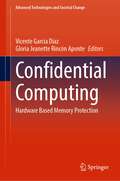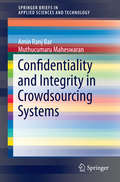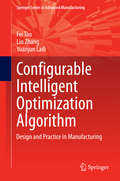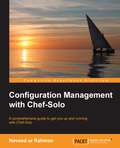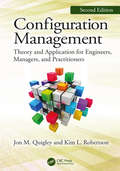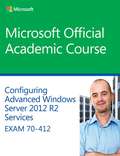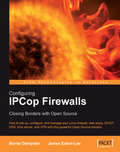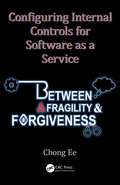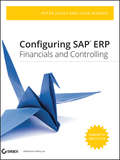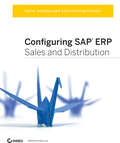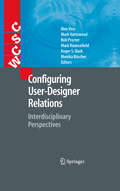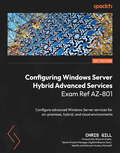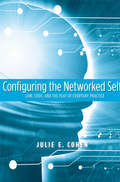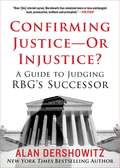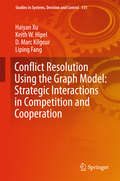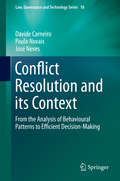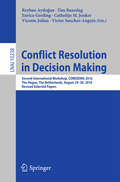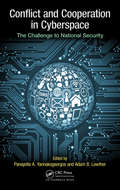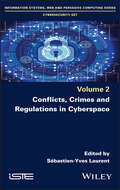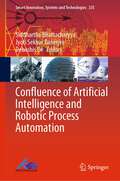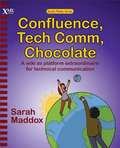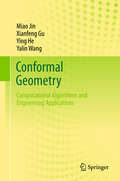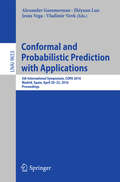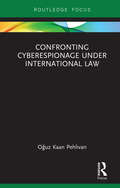- Table View
- List View
Confidential Computing: Hardware Based Memory Protection (Advanced Technologies and Societal Change)
by Vicente Garcia Diaz Gloria Jeanette Rincón AponteThis book highlights the three pillars of data security, viz protecting data at rest, in transit, and in use. Protecting data at rest means using methods such as encryption or tokenization so that even if data is copied from a server or database, a thief cannot access the information. Protecting data in transit means making sure unauthorized parties cannot see information as it moves between servers and applications. There are well-established ways to provide both kinds of protection. Protecting data while in use, though, is especially tough because applications need to have data in the clear—not encrypted or otherwise protected—in order to compute. But that means malware can dump the contents of memory to steal information. It does not really matter if the data was encrypted on a server’s hard drive if it is stolen while exposed in memory. As computing moves to span multiple environments—from on-premise to public cloud to edge—organizations need protection controls that help safeguard sensitive IP and workload data wherever the data resides. Many organizations have declined to migrate some of their most sensitive applications to the cloud because of concerns about potential data exposure. Confidential computing makes it possible for different organizations to combine data sets for analysis without accessing each other’s data.
Confidentiality and Integrity in Crowdsourcing Systems (SpringerBriefs in Applied Sciences and Technology)
by Amin Ranj Bar Muthucumaru MaheswaranConfidentiality and Integrity in Crowdsourcing Systems focuses on identity, privacy, and security related issues in crowdsourcing systems and in particular the confidentiality and integrity of online data created via crowdsourcing. This book begins with an introduction to crowdsourcing and then covers the privacy and security challenges of Confidentiality. The book examines integrity in these systems and the management and control of crowdsourcing systems.
Configurable Intelligent Optimization Algorithm: Design and Practice in Manufacturing (Springer Series in Advanced Manufacturing)
by Lin Zhang Fei Tao Yuanjun LailiPresenting the concept and design and implementation of configurable intelligent optimization algorithms in manufacturing systems, this book provides a new configuration method to optimize manufacturing processes. It provides a comprehensive elaboration of basic intelligent optimization algorithms, and demonstrates how their improvement, hybridization and parallelization can be applied to manufacturing. Furthermore, various applications of these intelligent optimization algorithms are exemplified in detail, chapter by chapter. The intelligent optimization algorithm is not just a single algorithm; instead it is a general advanced optimization mechanism which is highly scalable with robustness and randomness. Therefore, this book demonstrates the flexibility of these algorithms, as well as their robustness and reusability in order to solve mass complicated problems in manufacturing. Since the genetic algorithm was presented decades ago, a large number of intelligent optimization algorithms and their improvements have been developed. However, little work has been done to extend their applications and verify their competence in solving complicated problems in manufacturing. This book will provide an invaluable resource to students, researchers, consultants and industry professionals interested in engineering optimization. It will also be particularly useful to three groups of readers: algorithm beginners, optimization engineers and senior algorithm designers. It offers a detailed description of intelligent optimization algorithms to algorithm beginners; recommends new configurable design methods for optimization engineers, and provides future trends and challenges of the new configuration mechanism to senior algorithm designers.
Configuration Management with Chef-Solo
by Naveed Ur RahmanThis is a step-by-step guide, full of hands-on examples of real-world deployment tasks. Each topic is explained and placed in context, while also pointing out the key details of the concepts used. This book is aimed at system administrators and system engineers who have an understanding of configuration management tools and infrastructure. For novice administrators, it contains easy-to-use application recipes to get started immediately.
Configuration Management, Second Edition: Theory and Application for Engineers, Managers, and Practitioners
by Jon M. Quigley Kim L. RobertsonThe book provides a comprehensive approach to configuration management from a variety of product development perspectives, including embedded and IT. It provides authoritative advice on how to extend products for a variety of markets due to configuration options. The book also describes the importance of configuration management to other parts of the organization. It supplies an overview of configuration management and its process elements to provide readers with a contextual understanding of the theory, practice, and application of CM. The book illustrates the interplay of configuration and data management with all enterprise resources during each phase of a product lifecycle.
Configuring Advanced Windows Server® 2012 R2: Services Exam 70-412 (Microsoft Official Academic Course)
by Microsoft Official Academic Course StaffThis 70-412 Configuring Advanced Windows Server 2012 R2 Services textbook covers the third of three exams required for Microsoft Certified Solutions Associate (MCSA): Windows Server 2012 certification. This course will help validate the skills and knowledge necessary to administer a Windows Server 2012 Infrastructure in an enterprise environment. The three MCSA exams collectively validate the skills and knowledge necessary for implementing, managing, maintaining and provisioning services and infrastructure in a Windows Server 2012 environment. This Microsoft Official Academic Course is mapped to the 70-412 Configuring Advanced Windows Server 2012 Services exam skills, including the recent R2 objectives. This textbook focuses on real skills for real jobs and prepares students to prove mastery of Advanced Windows Server 2012 Services such as advanced configuring tasks necessary to deploy, manage, and maintain a Windows Server 2012 infrastructure.
Configuring IPCop Firewalls: Closing Borders with Open Source
by Barrie Dempster James Eaton-LeeAnyone interested in securing their networks with IPCop â " from those new to networking and firewalls, to networking and IT Professionals with previous experience of IPCop. No knowledge of Linux or IPCop is required.
Configuring Internal Controls for Software as a Service: Between Fragility and Forgiveness
by Chong EeThis book taps into an inherent paradox: with the ease of reliance on external, cloud providers to provide robust functionality and regular enhancements comes, as their very own audited service organization control (SOC) reports are quick to point out, the need for client organizations to devise and sustain a system of effective internal controls. By addressing the practitioner in the field, it provides tangible, cost effective and thus pragmatic means to mitigate key risks whilst leveraging built-in cloud capabilities and overarching principles of effective system design.
Configuring SAP ERP Financials and Controlling
by Peter Jones John BurgerSAP is the world leader in Enterprise Resource Planning (ERP) software; of the software?s modules, the FI (Finance) and CO (Controlling) are by far the most popular and are widely implemented. This book has no competition?it is the only book on the market on how to configure and implement SAP?s FI and CO modules to maximize functionality and features hands-on, step-by-step instructions and real-world examples that provide immediate and practical solutions. Updated for SAP?s ECC 6.0, the book covers FI enterprise structure, general ledger, substitutions and validations, automatic account assignments, accounts payable and receivable, asset accounting, accrual engine, closing entries, credit management, lockbox, CO enterprise structure, profitability analysis (CO-PA), and more.
Configuring SAP ERP Sales and Distribution
by Kapil Sharma Ashutosh MutsaddiThe first and only book to offer detailed explanations of SAP ERP sales and distributionAs the only book to provide in-depth configuration of the Sales and Distribution (SD) module in the latest version of SAP ERP, this valuable resource presents you with step-by-step instruction, conceptual explanations, and plenty of examples. If you're an SD consultant or are in charge of managing an SAP implementation in your enterprise, you'll want this valuable resource at your sideSAP is one of the leading Enterprise Resource Planning (ERP) software products on the market, with over 40,000 implementationsCovers the latest version of SAP ERP-ECC 6.0Covers common through advanced configurations, so it's helpful no matter what your level of experience with SAPExplains the conceptual framework behind the configuration processIf your company uses the SD module, keep this indispensable guide on hand.
Configuring SonicWALL Firewalls
by Simon Desmeules Barry J. StiefelConfiguring SonicWALL Firewal is the first book to deliver an indepth look at the SonicWALL firewall product line. It covers all of the aspects of the SonicWALL product line from the SOHO devices to the Enterprise SonicWALL firewalls. Also covered are advanced troubleshooting techniques and the SonicWALL Security Manager. This book offers novice users a complete opportunity to learn the SonicWALL firewall appliance. Advanced users will find it a rich technical resource.
Configuring User-Designer Relations: Interdisciplinary Perspectives (Computer Supported Cooperative Work)
by Mark Rouncefield Roger Slack Rob Procter Monika Büscher Mark Hartswood Alex Voss'User-designer relations' concerns the sorts of working relationships that arise between developers and end users of IT products - the different ways designers of IT products seek to engage with users, and the ways users seek to influence product design. It is through the shifting patterns of these relations that IT products are realised. Although it has generally been accepted that achieving better user-designer relations will improve the quality of IT products, there has been little consensus on how this might be achieved. This book aims to deepen our understanding of the relationships between users and designers both as they emerge in the wild and as a consequence of our attempts to intervene. Through a series of case studies the book juxtaposes in-depth explorations of different perspectives and approaches to thinking about - and doing - user-designer relations, considering important implications for design and computer science more generally.
Configuring Windows Server Hybrid Advanced Services Exam Ref AZ-801: Configure advanced Windows Server services for on-premises, hybrid, and cloud environments
by Chris Gill Shannon KuehnAce the AZ 801 exam and master advanced Windows Server and Infrastructure-as-a-Service workload administration with this comprehensive guidePurchase of the print or Kindle book includes a free PDF eBookKey FeaturesGain practical knowledge to conquer the AZ-801 certification and tackle real-world challengesLearn to secure Windows Server in on-premises and hybrid infrastructuresLeverage hands-on examples to monitor and troubleshoot Windows Server environmentsBook DescriptionConfiguring Windows Server Hybrid Advanced Services Exam Ref AZ-801 helps you master various cloud and data center management concepts in detail, helping you grow your expertise in configuring and managing Windows Server in on-premises, hybrid, and cloud-based workloads. Throughout the book, you'll cover all the topics needed to pass the AZ-801 exam and use the skills you acquire to advance in your career.With this book, you'll learn how to secure your on-premises Windows Server resources and Azure IaaS workloads. First, you'll explore the potential vulnerabilities of your resources and learn how to fix or mitigate them. Next, you'll implement high availability Windows Server virtual machine workloads with Hyper-V Replica, Windows Server Failover Clustering, and Windows File Server.You'll implement disaster recovery and server migration of Windows Server in on-premises and hybrid environments. You'll also learn how to monitor and troubleshoot Windows Server environments.By the end of this book, you'll have gained the knowledge and skills required to ace the AZ-801 exam, and you'll have a handy, on-the-job desktop reference guide.What you will learnUnderstand the core exam objectives and successfully pass the AZ-801 examSecure Windows Server for on-premises and hybrid infrastructures using security best practicesImplement, manage, and monitor Windows Server high availability features successfullyConfigure and implement disaster recovery services using Hyper-V features, Azure Recovery Services, and Azure Site RecoveryExplore how to migrate various servers, workloads, and tools from previous versions of Windows Server to 2022Monitor and troubleshoot Windows Server environments in both on-premises and cloud workloads using Windows Server tools, Windows Admin Center, and Azure servicesWho this book is forThis book is for Cloud and Datacenter Management administrators and engineers, Enterprise Architects, Microsoft 365 Administrators, Network Engineers, and anyone seeking to gain additional working knowledge with Windows Server operating systems and managing on-premises, hybrid and cloud workloads with administrative tools. To get started, you'll need to have a basic understanding of how to configure advanced Windows Server services utilizing existing on-premises technology in combination with hybrid and cloud technologies.
Configuring the Networked Self
by Julie E. CohenThe legal and technical rules governing flows of information are out of balance, argues Julie E. Cohen in this original analysis of information law and policy. Flows of cultural and technical information are overly restricted, while flows of personal information often are not restricted at all. The author investigates the institutional forces shaping the emerging information society and the contradictions between those forces and the ways that people use information and information technologies in their everyday lives. She then proposes legal principles to ensure that people have ample room for cultural and material participation as well as greater control over the boundary conditions that govern flows of information to, from, and about them.
Confirming Justice—Or Injustice?: A Guide to Judging RBG's Successor
by Alan DershowitzIn Confirming Justice—Or Injustice?, Alan Dershowitz—New York Times bestselling author and one of America&’s most respected legal scholars—contemplates the past, present, and future of the Supreme Court, from the death of Ruth Bader Ginsburg to the confirmation battle looming over President Trump&’s nomination of Judge Amy Coney Barrett. Alan Dershowitz has been called &“one of the most prominent and consistent defenders of civil liberties in America&” by Politico and &“the nation&’s most peripatetic civil liberties lawyer and one of its most distinguished defenders of individual rights&” by Newsweek. He is also a fair-minded and even-handed expert on the Constitution and American government, and in this book offers his knowledge and insight to help readers understand the current circumstances surrounding the Supreme Court and the looming partisan battle for its future. Confirming Justice—Or Injustice? is an analysis of every aspect of the possible confirmation of Judge Amy Coney Barrett to fill the vacant seat left by the death of Ruth Bader Ginsburg. It includes timely commentary on the history and process of confirming justices to the Supreme Court, notes about what might happen if the process is changed—such as by court packing or instituting age or term limits for justices—and discussion of the roles of the various people and groups who might have input on the confirmation, from the president to the senate to the judiciary committee to the Constitution itself. In the end, Confirming Justice—Or Injustice? represents an icon in American law and politics reckoning with an increasingly politicized and polarized nomination-and-confirmation process for judges and what those shifts might mean for the country, both now and in days to come. It is essential reading for anyone interested in or concerned about Trump's nomination of Amy Coney Barrett and the process of her possible confirmation, the legacy of Ruth Bader Ginsburg, and the future and fate of the Supreme Court—and American democracy itself.
Conflict Resolution Using the Graph Model: Strategic Interactions in Competition and Cooperation (Studies in Systems, Decision and Control #153)
by D. Marc Kilgour Keith W. Hipel Liping Fang Haiyan XuThis cutting-edge book presents the theory and practice of the Graph Model for Conflict Resolution (GMCR), which is used for strategically investigating disputes in any field to enable informed decision making. It clearly explains how GMCR can determine what is the best a particular decision maker (DM) can independently achieve in dynamic interaction with others. Moves and counter-moves follow various stability definitions reflecting human behavior under conflict. The book defines a wide range of preference structures to represent a DM’s comparisons of states or scenarios: equally preferred, more or less preferred; unknown; degrees of strength of preference; and hybrid. It vividly describes how GMCR can ascertain whether a DM can fare even better by cooperating with others in a coalition. The book portrays how a conflict can evolve from the status quo to a desirable resolution, and provides a universal design for a decision support system to implement the innovative decision technologies using the matrix formulation of GMCR. Further, it illustrates the key ideas using real-world conflicts and supplies problems at the end of each chapter. As such, this highly instructive book benefits teachers, mentors, students and practitioners in any area where conflict arises.
Conflict Resolution and its Context: From the Analysis of Behavioural Patterns to Efficient Decision-Making (Law, Governance and Technology Series #18)
by Davide Carneiro Paulo Novais José NevesThis book studies how technological solutions can be used to alleviate the current state of legal systems, with their clogged up courtrooms and inefficient conflict resolution methods. It reviews the shortcomings and disadvantages of traditional and alternative conflict resolution methods and turns to Artificial Intelligence for problem-solving techniques and solutions. The book is divided into four parts. The first part presents a general and systematic analysis of the current state of the legal systems, identifying the main problems and their causes It then moves on to present UM Court: a framework for testing and prototyping conflict resolution services. This framework was developed with the objective of using Artificial Intelligence techniques to build a service environment for conflict resolution. The third part of the book takes a step into the future by analyzing the use of Intelligent Environments in the support of conflict management and resolution. It describes the approach taken and the experiments performed in the Intelligent Systems Lab of the University of Minho. The final part of the book contains the conclusions and shows the potential advantages of the use of Intelligent Environments as a way to implement better conflict resolution procedures (virtual or real), in which all the participants have access to more and better information and are able to take better informed decisions.
Conflict Resolution in Decision Making: Second International Workshop, COREDEMA 2016, The Hague, The Netherlands, August 29-30, 2016, Revised Selected Papers (Lecture Notes in Computer Science #10238)
by Tim Baarslag Vicente Julian Reyhan Aydoğan Enrico Gerding Catholijn M. Jonker Victor Sanchez-AnguixThis book constitutes thoroughly revised selected papers of the Second International Workshop on Conflict and Resolution in Decision Makrung, COREDEMA 2016, held in The Hague, The Netherlands, in August 2016. The 9 revised papers presented were carefully reviewed and selected from 13 submissions. The 2nd International Workshop on Conflict Resolution in Decision Making (COREDEMA 2016) focuses on theoretical and practical computational approaches for solving and understanding conflict resolution.
Conflict and Cooperation in Cyberspace: The Challenge to National Security
by Adam B. Lowther Panayotis A. YannakogeorgosConflict and Cooperation in Cyberspace: The Challenge to National Security brings together some of the world's most distinguished military leaders, scholars, cyber operators, and policymakers in a discussion of current and future challenges that cyberspace poses to the United States and the world. Maintaining a focus on policy-relevant solutions, i
Conflicts, Crimes and Regulations in Cyberspace
by Sébastien-Yves LaurentThe study of cyberspace is relatively new within the field of social sciences, yet interest in the subject is significant. Conflicts, Crimes and Regulations in Cyberspace contributes to the scientific debate being brought to the fore by addressing international and methodological issues, through the use of case studies.This book presents cyberspace as a socio-technical system on an international level. It focuses on state and non-state actors, as well as the study of strategic concepts and norms. Unlike global studies, the socio-technical approach and “meso” scale facilitate the analysis of cyberspace in international relations. This is an area of both collaboration and conflict for which specific modes of regulation have appeared.
Confluence of Artificial Intelligence and Robotic Process Automation (Smart Innovation, Systems and Technologies #335)
by Debashis De Siddhartha Bhattacharyya Jyoti Sekhar BanerjeeThis book provides a detailed insight into Robotic Process Automation (RPA) technologies linked with AI that will help organizations implement Industry 4.0 procedures. RPA tools enhance their functionality by incorporating AI objectives, such as use of artificial neural network algorithms, text mining techniques, and natural language processing techniques for information extraction and the subsequent process of optimization and forecasting scenarios for the purpose of improving an organization's operational and business processes. The target readers of this book are researchers, professors, graduate students, scientists, policymakers, professionals, and developers working in the IT and ITeS sectors, i.e. people who are working on emerging technologies. This book also provides insights and decision support tools necessary for executives concerned with different industrial and organizational automation-centric jobs, knowledge dissemination, information, and policy development for automation in different educational, government, and non-government organizations. This book is of special interest to college and university educators who teach AI, machine learning, blockchain, business intelligence, cognitive intelligence, and brain intelligence courses in different capacities.
Confluence, Tech Comm, Chocolate
by Sarah MaddoxWeb and Tech Comm guru Sarah Maddox takes you inside the Confluence wiki for an in-depth guide to developing and publishing technical documentation on a wiki. She looks at life on a wiki from the points of view of both technical writers and readers. Confluence, Tech Comm, Chocolate shows you how to make your wiki fly.While it focuses on Confluence, the concepts and strategies can be used with any wiki. The basic message is that technical documentation becomes true communication when you add the social and collaborative tools that a wiki provides.Inside the Book Introduction Developing Technical Documentation on a Wiki Life on a Wiki Giving Your Wiki Wings Glossary and Index
Conformal Geometry: Computational Algorithms And Engineering Applications (Advanced Lectures In Mathematics Ser.)
by Ying He Miao Jin Xianfeng Gu Yalin WangThis book offers an essential overview of computational conformal geometry applied to fundamental problems in specific engineering fields. It introduces readers to conformal geometry theory and discusses implementation issues from an engineering perspective.The respective chapters explore fundamental problems in specific fields of application, and detail how computational conformal geometric methods can be used to solve them in a theoretically elegant and computationally efficient way. The fields covered include computer graphics, computer vision, geometric modeling, medical imaging, and wireless sensor networks. Each chapter concludes with a summary of the material covered and suggestions for further reading, and numerous illustrations and computational algorithms complement the text.The book draws on courses given by the authors at the University of Louisiana at Lafayette, the State University of New York at Stony Brook, and Tsinghua University, and will be of interest to senior undergraduates, graduates and researchers in computer science, applied mathematics, and engineering.
Conformal and Probabilistic Prediction with Applications: 5th International Symposium, COPA 2016, Madrid, Spain, April 20-22, 2016, Proceedings (Lecture Notes in Computer Science #9653)
by Alexander Gammerman Zhiyuan Luo Jesús Vega Vladimir VovkThis book constitutes the refereed proceedings of the 5th InternationalSymposium on Conformal and Probabilistic Prediction with Applications, COPA2016, held in Madrid, Spain, in April 2016. The 14 revised fullpapers presented together with 1 invited paper were carefully reviewed andselected from 23 submissions and cover topics on theory of conformal prediction; applicationsof conformal prediction; and machine learning.
Confronting Cyberespionage Under International Law (Routledge Research in International Law)
by Oğuz Kaan PehlivanWe have witnessed a digital revolution that affects the dynamics of existing traditional social, economic, political and legal systems. This revolution has transformed espionage and its features, such as its purpose and targets, methods and means, and actors and incidents, which paves the way for the emergence of the term cyberespionage. This book seeks to address domestic and international legal tools appropriate to adopt in cases of cyberespionage incidents. Cyberespionage operations of state or non-state actors are a kind of cyber attack, which violates certain principles of international law but also constitute wrongful acquisition and misappropriation of the data. Therefore, from the use of force to state responsibility, international law offers a wide array of solutions; likewise, domestic regulations through either specialized laws or general principles stipulate civil and criminal remedies against cyberespionage. Confronting Cyberespionage Under International Law examines how espionage and its applications have transformed since World War II and how domestic and international legal mechanisms can provide effective legal solutions to this change, hindering the economic development and well-being of individuals, companies and states to the detriment of others. It shows the latest state of knowledge on the topic and will be of interest to researchers, academics, legal practitioners, legal advisors and students in the fields of international law, information technology law and intellectual property law.
